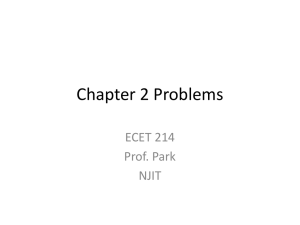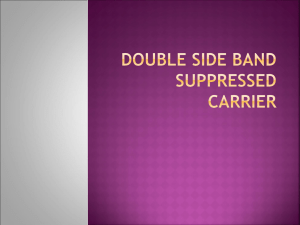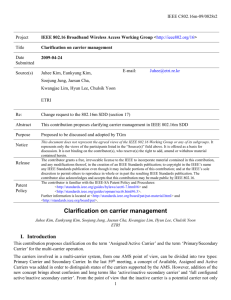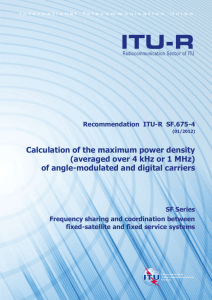Radio Access Technologies FDMA, TDMA, CDMA, DSSS
advertisement
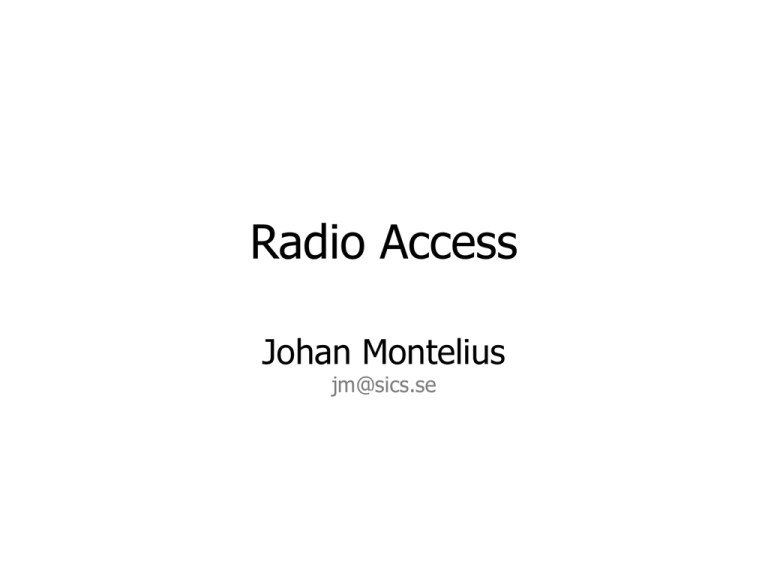
Radio Access Johan Montelius jm@sics.se Shannon C = W x log2(1 + S/N) The capacity [C] in bits/s is directly proportional to the available bandwidth [W] and log2 proportional to the signal to noise ratio [S/N]. bandwidth & power S/N = 1 Capacity increase 8 6 increase W increase S 4 2 0 1 2 3 4 5 S or W increase 6 7 8 Attenuation in open space Sr = S0/4r2 The signal strength at a distance [Sr] is directly proportional to the sending strength [S0] and indirectly proportional to square of the distance [r] Real life In urban environment the signal strength is proportional to 1/rk where k = 1,6 … 3,8 Distance costs signal strength Sr = S/r3,5 0,035 0,030 0,025 0,020 0,015 0,010 0,005 0,000 S=1 S=2 S=4 1 2 3 4 5 6 7 distance from sender 8 Too bad for broadcast but good for cellular systems Not a problem good quality detectable What is interference Rules of thumb • Bandwidth – most important factor to increase capacity • Power – will buy you distance but at a high cost • Noise – your own signal can be the worst problem Divide the resources • Space – systems ”far” apart don’t interfere with each other • Frequency – modulate the signal to use a specified frequency band • Time – synchronize and allocate time slots • Code – Information coding National/International regulations MSS ITU EU IMT 2000 GSM 1800 UMTS DECT MDS US PCS Jp/Ko China IMT 2000 GSM 1800 1800 IMT 2000 1850 1900 1950 2000 2050 2100 2150 2200 2250 Frequency division • By modulating a carrier frequency, the radiated power can be limited to a specified frequency range. • The width of the range is the bandwidth of the carrier. • A guard band is needed to protect adjacent carriers. Frequency planning A B C 3 cells per site typically used in urban environment Frequency planning 4 sites, 3 cells per site 12 carriers needed minimum distance A B D E C J F G H K L I A Time division • • • • Enabled by faster processors. A carrier is divided into time slots. Each channel is allocated a time slot. A guard period is needed between adjacent time slots Timing advance A sender must adjust its transmission to meet the time slot at the receiver. The farther away the earlier you send . The base station will tell you if your late or early. a b B A Locating a mobile terminal 500 m What is left ? • when bandwidth is fixed • and power is limited • do the best modulation possible Modulation • • • • • frequency modulation amplitude modulation phase modulation combination of above … no modulation ? Wireless systems • Often use a phase modulation • Could change modulation depending on quality of signal • Spectral efficiency – up to 2 bits raw data per Hz under good conditions – aprx 0,5 to 1 bit user data per Hz – limited by signal to noise ratio How do we compare? • What is the maximum user capacity? • What is the maximum capacity of a system? • How many carriers do we have? • What is the total capacity of a carrier? • How many carriers can be used at any given point? GSM • Each duplex carrier is 2x200 KHz wide • 900 – up 890-915 MHz down 935-960 MHz – 124 duplex carriers – 2x25MHz in total • 1800 – up 1710-1785 MHz down 1805-1880 MHz – 374 duplex carriers – 2x75MHz in total !!!!! • 1900 (in the US) – up 1850-1910 MHz down 1930-1990 – 2x60MHz in total GSM • Time division – 8 time slots per carrier – one carrier up one carrier down • Gaussian Minimum Shift Keying (GMSK) – user bitrate 9,6 kb/s or 14,4 kb/s per timeslot – raw bitrate 272 kb/s per carrier • HSCSD – Two or more time slots Up and down 0 1 2 3 4 5 6 7 down up The up link is delayed 3 slots in order to give the terminal time to adjust to the new frequency. Time slots 5 and 6 can be used to listen for better frequencies. GPRS • Dynamically allocate time slots – normally 1:4 one up, four down • Data and voice can be combined • Coding schemes (user data rates) – CS – CS – CS – CS 1: 2: 3: 4: 9,05 13,4 15,6 21,4 kb/s kb/s kb/s kb/s total 72,4 kb/s total 107,2 kb/s total 124,8 kb/s total 171,2 kb/s EDGE • Enhanced data rate for GSM Evolution • Change the modulation to 8-PSK i.e. 3 bits per symbol • User data rate – 22,8 kb/s to 69,2 kb/s – Total of 553 kb/s – don’t move UMTS/WCDMA • • • • Each paired carrier is 2x5MHz 1900-1980, 2010-2025, 2110-2170 MHz 155 MHz in total Unpaired carriers can be used using time-division duplex mode (TDD) • A typical operator – Two or three paired, one unpaired – Up to six operators share the spectrum ISM 2.4 GHz • Industrial, Scientific and Medical – US 2400 – 24835 83,5MHz in total – Japan 2400 – 2497 89,7MHz in total • Open for anyone, no license • Limitation on power < 0.1W (<1W US) • Using a spread spectrum technique Spread spectrum • Why spread the signal over a wider spectrum? – more robust, will survive if part of the spectrum is noisy – will allow other systems to operate in the same environment • Two techniques – frequency hopping – direct sequence Frequency Hopping • divide the spectrum into separate carriers – In ISM, FCC regulated at least 70 carriers • transmit and hop – In ISM, FCC regulates < 400 ms • a code determines where to hop – how do we synchronize? • low cost, low power, very robust Direct Sequence • Increase the bandwidth by sending a pattern, chipping sequence, at a higher bitrate • sequence can be static or dynamic – dynamic patterns are used in CDMA • high bitrate, robust Bluetooth 1.1 • Frequency hopping, GFSK modulation – Gaussian Frequency Shift Key • 79 carriers of 1 MHz, 1600 hops per s • Power – Class 1: 20dBm (100mW) range aprx 100m – Class 2: 4dBm (2,5 mW) range aprx 10m – Class 3: 0dbM (1 mW) range aprx 10 cm • Master & Slave – Master determines hopping sequence • Capacity 712 Kb/s per channel 802.11b • DSSS, BPSK (1Mbps) QPSK (11Mbps) • ISM 2.4 – US 11 carriers – Europe (except France and Spain) 13 carriers – Japan 14 carriers • Carrier – 22 MHz wide – can use 3 carriers without overlap! 802.11b • 1 Mb/s using BPSK – Barker spread sequence of 11 bits • 2 Mb/s using QPSK – Barker sequence of 11 bits (22 Mb/s raw data) • 5,5 and 11 Mb/s – – – – – QPSK, same as for 2Mb/s complementary code keying 1,375M symbols/s each symbol is 8 bits long (11 Mb/s raw data) each symbol represents 4 or 8 bits 802.11b 11 Mb/s 8 b/symbol 8 chips/symbol 1,375 Msymb/s QPSK 5,5 Mb/s 4 b/symbol 8 chips/symbol 1,375 Msymb/s QPSK 2 Mb/s 1 b/symbol 11 chips/symbol 2 Msymb/s QPSK 1 Mb/s 1 b/symbol 11 chips/symbol 1 Msymb/s BPSK Code division • Same frequency can be used • No cell planning • How do we decode the message? Code division: coding 1 message di d1 d2 -1 1 code cik -1 1 out zik -1 Zik= dik * cik Code division: decoding 1 out zik -1 1 code cik -1 S m di = 1 m zikcik k=1 d1 = 1 8 (-1 –1 – 1 –1 – 1 – 1 –1 – 1) = -1 Code division: multiple senders Da = -1-1-1-1-1-1-1-1+1+1+1+1+1+1+1+1 Ca = +1+1+1-1+1-1-1-1+1+1+1-1+1-1-1-1 Za = -1-1-1+1-1+1+1+1+1+1+1-1+1-1-1-1 Db = +1+1+1+1+1+1+1+1+1+1+1+1+1+1+1+1 Cb = +1-1+1+1+1-1+1+1+1-1+1+1+1-1+1+1 Zb = +1-1+1+1+1-1+1+1+1-1+1+1+1-1+1+1 Code division Za = -1-1-1+1-1+1+1+1+1+1+1-1+1-1-1-1 Zb = +1-1+1+1+1-1+1+1+1-1+1+1+1-1+1+1 Zab= +0-2+0+2+0+0+2+2+2+0+2+0+2-2+0+0 Zab= +0-2+0+2+0+0+2+2+2+0+2+0+2-2+0+0 Ca = +1+1+1-1+1-1-1-1+1+1+1-1+1-1-1-1 ZCa= +0-2+0-2+0+0-2-2+2+0+2+0+1+2+0+0 Sa= -8/8 = -1 +8/8 = +1 UWB • Ultra wide band – More than 1.5 GHz or 20% of central frequency • Use low power, low enough to disappear in noise level of other systems • Compensate by using large bandwidth, up to several GHz • Distance is, due to low power, limited < 10 m Shannon revisited • Shannon’s theorem sets a limit for one receiver listening to one message. • What happens if we have several channels open, multiple receivers. • Is there a limitation on capacity in space? WCDMA • 5 MHz carrier • QPSK modulation • 3,84 Mcps chipping rate






